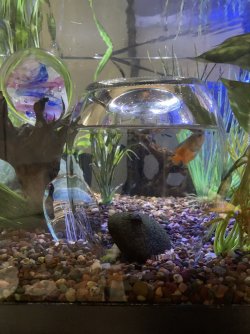Update: the ill fish has now died.
Hello! I am new to the forum. Have had an aquarium for awhile but still very much a beginner in knowledge!
Context: I have a 30 gallon tank. I added a few fish (3 Cory’s and 2 Dwarf Gouramis) on Sunday. I have “room” for several more fish so there should be no issue with over crowding. All was well until after feed this morning (Friday) when I found this dwarf gourami floating, vertically, nose up. Thought it had died but when I went to remove it, it’s very much alive. Tested water, all ok, though chlorine may be a bit high so I added Prime to the whole tank. I don’t have a 2nd tank for quarantine or treatment. Removed it to a large jar while I observed and researched. It mostly floats at top but also struggles to swim straight when trying to move. Nearly certain it is swim bladder problem, possibly from eating floating food too quickly.
Recommendation seems to be to reduce stress by removing it from other fish who may bothering it (which they were) and allow it to fast for 3 days while also keeping warm. Don’t have a way to keep water in jar warm so…my solution is jar upside down in tank (see photo).
My query: oxygenation in the jar? How often might I need to refresh the water in there. Might the bubble I left at the top be sufficient? For how long? Any insight would be appreciated!
Hello! I am new to the forum. Have had an aquarium for awhile but still very much a beginner in knowledge!
Context: I have a 30 gallon tank. I added a few fish (3 Cory’s and 2 Dwarf Gouramis) on Sunday. I have “room” for several more fish so there should be no issue with over crowding. All was well until after feed this morning (Friday) when I found this dwarf gourami floating, vertically, nose up. Thought it had died but when I went to remove it, it’s very much alive. Tested water, all ok, though chlorine may be a bit high so I added Prime to the whole tank. I don’t have a 2nd tank for quarantine or treatment. Removed it to a large jar while I observed and researched. It mostly floats at top but also struggles to swim straight when trying to move. Nearly certain it is swim bladder problem, possibly from eating floating food too quickly.
Recommendation seems to be to reduce stress by removing it from other fish who may bothering it (which they were) and allow it to fast for 3 days while also keeping warm. Don’t have a way to keep water in jar warm so…my solution is jar upside down in tank (see photo).
My query: oxygenation in the jar? How often might I need to refresh the water in there. Might the bubble I left at the top be sufficient? For how long? Any insight would be appreciated!
Attachments
Last edited:




